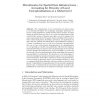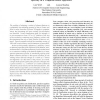60 search results - page 3 / 12 » Implicit spatial inference with sparse local features |
117
click to vote
BMVC
1998
15 years 2 months ago
1998
We introduce an object recognition system in which objects are represented as a sparse and spatially organized set of local (bent) line segments. The line segments correspond to b...
BMCBI
2010
15 years 1 months ago
2010
Background: Sub-cellular structures interact in numerous direct and indirect ways in order to fulfill cellular functions. While direct molecular interactions crucially depend on s...
152
click to vote
GISCIENCE
2010
Springer
15 years 1 months ago
2010
Springer
The categorization of our environment into feature types is an essential prerequisite for cartography, geographic information retrieval, routing applications, spatial decision supp...
125
click to vote
ICCV
2003
IEEE
16 years 3 months ago
2003
IEEE
The problem of selecting a subset of relevant features in a potentially overwhelming quantity of data is classic and found in many branches of science. Examples in computer vision...
118
click to vote
ECCV
2004
Springer
16 years 3 months ago
2004
Springer
We consider object recognition as the process of attaching meaningful labels to specific regions of an image, and propose a model that learns spatial relationships between objects....


